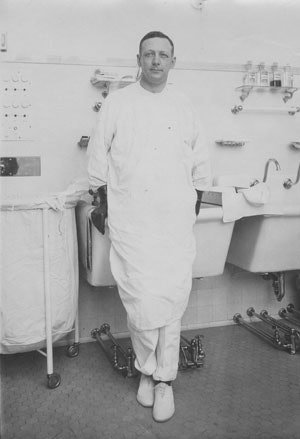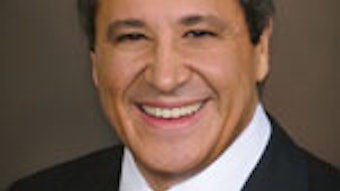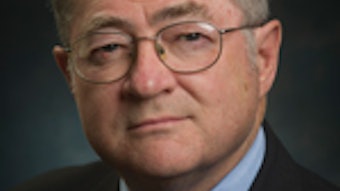Thyroglossal Duct Cysts, Elephantitis, and More: The Different Sides of Walter E. Sistrunk
Amit A. Patel, MD Otolaryngology History Society (OHS) Treatment of the thyroglossal duct cyst was revolutionized by Walter Ellis Sistrunk, MD, of the Mayo Clinic in 1920 and the development of the procedure that now bears his name. Since that time, the procedure has remained, for the most part, unchanged and is the gold standard for treatment of thyroglossal duct cysts. Dr. Sistrunk was also a consummate general surgeon, who made contributions not only to thyroid surgery, but also to fields as diverse as oncologic breast surgery and vascular surgery. Born in Tallahassee, AL, in 1880, Dr. Sistrunk received a degree in pharmacy from the Alabama Polytechnic Institute in 1900. From there, he attended TulaneMedicalCollege, graduating in 1906. He began his career in private surgical practice in New Orleans and Lake Charles, LA. He moved to the Mayo Clinic in 1911 as an assistant in the department of pathology. There he published a landmark paper on intestinal parasites in which he demonstrated that the incidence of amebiasis was more widespread in the United States than had previously been thought. This paper was cited for more than two decades as a preeminent paper on parasitology. In 1912, from the Mayo Clinic’s department of parasitology, Dr. Sistrunk moved to its department of surgery and in 1918 he was appointed as assistant professor. In 1921, he published his most famous work on the surgical treatment of cysts of the thyroglossal duct tract. He discovered the key to avoiding recurrence was removal of the entire epithelial-lined tract extending to the base of the tongue. The procedure is so efficacious that it has remained essentially unchanged in the last century and rightly bears his name. Dr. Sistrunk also made significant advances in the surgical treatment of chronic lymphedema or elephantiasis. He modified an earlier operation known as the Kondoleon operation, in which large swaths of tissue are removed from the edematous limb to provide relief from symptoms. While this procedure is rarely performed today, contemporary physicians noted Dr. Sistrunk’s contribution to the point where some literature refers to the Kondoleon operation as the Sistrunk operation. Dr. Sistrunk continued his work and research at the Mayo Clinic until 1929, when he moved to BaylorUniversity, returning to his native South after his son died in an accident. His rich contributions to the fields of surgery and medicine cannot be underestimated. In a larger sense, however, it is important to remember that physicians should not be pigeonholed into their medical eponyms. For example, Theodor Billroth is remembered for his surgical treatment of peptic ulcer disease, but, lest we forget, he performed the first total laryngectomy. Similarly, George W. Crile is known for his contributions to neck dissections, but we should also remember that he performed the first successful blood transfusion. We should not do away with eponyms altogether, however, as doing so would dismayingly cause us to lose a sense of connection with the history of our field.
 Walter W. Sistrunk, MD (1880-1933)
Walter W. Sistrunk, MD (1880-1933)Amit A. Patel, MD
Otolaryngology History Society (OHS)
Treatment of the thyroglossal duct cyst was revolutionized by Walter Ellis Sistrunk, MD, of the Mayo Clinic in 1920 and the development of the procedure that now bears his name.
Since that time, the procedure has remained, for the most part, unchanged and is the gold standard for treatment of thyroglossal duct cysts. Dr. Sistrunk was also a consummate general surgeon, who made contributions not only to thyroid surgery, but also to fields as diverse as oncologic breast surgery and vascular surgery.
Born in Tallahassee, AL, in 1880, Dr. Sistrunk received a degree in pharmacy from the Alabama Polytechnic Institute in 1900. From there, he attended TulaneMedicalCollege, graduating in 1906. He began his career in private surgical practice in New Orleans and Lake Charles, LA.
He moved to the Mayo Clinic in 1911 as an assistant in the department of pathology. There he published a landmark paper on intestinal parasites in which he demonstrated that the incidence of amebiasis was more widespread in the United States than had previously been thought. This paper was cited for more than two decades as a preeminent paper on parasitology.
In 1912, from the Mayo Clinic’s department of parasitology, Dr. Sistrunk moved to its department of surgery and in 1918 he was appointed as assistant professor. In 1921, he published his most famous work on the surgical treatment of cysts of the thyroglossal duct tract.
He discovered the key to avoiding recurrence was removal of the entire epithelial-lined tract extending to the base of the tongue. The procedure is so efficacious that it has remained essentially unchanged in the last century and rightly bears his name.
Dr. Sistrunk also made significant advances in the surgical treatment of chronic lymphedema or elephantiasis. He modified an earlier operation known as the Kondoleon operation, in which large swaths of tissue are removed from the edematous limb to provide relief from symptoms. While this procedure is rarely performed today, contemporary physicians noted Dr. Sistrunk’s contribution to the point where some literature refers to the Kondoleon operation as the Sistrunk operation.
Dr. Sistrunk continued his work and research at the Mayo Clinic until 1929, when he moved to BaylorUniversity, returning to his native South after his son died in an accident. His rich contributions to the fields of surgery and medicine cannot be underestimated.
In a larger sense, however, it is important to remember that physicians should not be pigeonholed into their medical eponyms. For example, Theodor Billroth is remembered for his surgical treatment of peptic ulcer disease, but, lest we forget, he performed the first total laryngectomy. Similarly, George W. Crile is known for his contributions to neck dissections, but we should also remember that he performed the first successful blood transfusion.
We should not do away with eponyms altogether, however, as doing so would dismayingly cause us to lose a sense of connection with the history of our field.
















